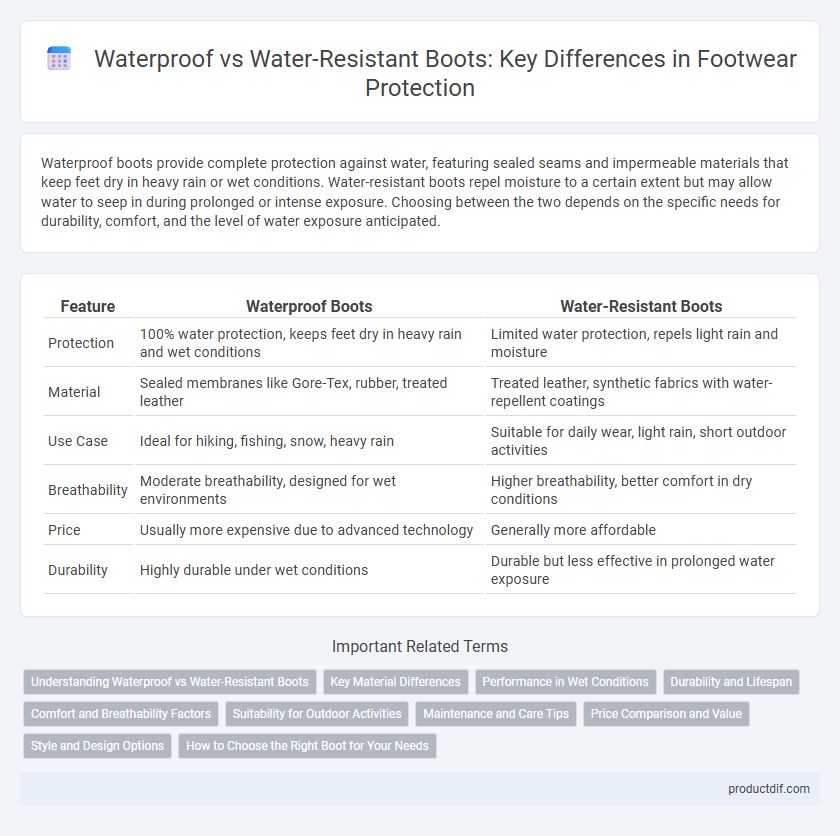Waterproof boots provide complete protection against water, featuring sealed seams and impermeable materials that keep feet dry in heavy rain or wet conditions. Water-resistant boots repel moisture to a certain extent but may allow water to seep in during prolonged or intense exposure. Choosing between the two depends on the specific needs for durability, comfort, and the level of water exposure anticipated.
Table of Comparison
| Feature | Waterproof Boots | Water-Resistant Boots |
|---|---|---|
| Protection | 100% water protection, keeps feet dry in heavy rain and wet conditions | Limited water protection, repels light rain and moisture |
| Material | Sealed membranes like Gore-Tex, rubber, treated leather | Treated leather, synthetic fabrics with water-repellent coatings |
| Use Case | Ideal for hiking, fishing, snow, heavy rain | Suitable for daily wear, light rain, short outdoor activities |
| Breathability | Moderate breathability, designed for wet environments | Higher breathability, better comfort in dry conditions |
| Price | Usually more expensive due to advanced technology | Generally more affordable |
| Durability | Highly durable under wet conditions | Durable but less effective in prolonged water exposure |
Understanding Waterproof vs Water-Resistant Boots
Waterproof boots feature impermeable materials and sealed seams to prevent any water from entering, making them ideal for heavy rain, snow, or wet conditions. Water-resistant boots use treated fabrics or coatings that repel water but can eventually allow moisture to seep through during prolonged exposure. Choosing between waterproof and water-resistant depends on the intensity of water exposure and the need for breathability and comfort in footwear.
Key Material Differences
Waterproof boots feature impermeable materials such as Gore-Tex membranes or rubber to completely block water penetration, ensuring dry feet in heavy rain or wet environments. Water-resistant boots typically utilize treated leather or coated fabrics that repel water but allow some moisture through under prolonged exposure. The key material distinction lies in the waterproof boots' sealed seams and specialized membranes versus the water-resistant boots' surface-level treatments and less comprehensive water barriers.
Performance in Wet Conditions
Waterproof boots provide superior protection against prolonged exposure to water through sealed seams and waterproof membranes, ensuring dry feet in heavy rain and wet environments. Water-resistant boots repel light moisture and splashes but may allow water to seep in during extended or intense exposure. Performance in wet conditions is significantly enhanced in waterproof boots, making them ideal for hiking, fishing, or working in consistently wet areas.
Durability and Lifespan
Waterproof boots are constructed with sealed seams and durable materials like Gore-Tex, offering superior protection against moisture and typically lasting longer in wet conditions compared to water-resistant boots. Water-resistant boots utilize treated fabrics or coatings that repel water temporarily but wear down over time, reducing their effectiveness and lifespan. The durability of waterproof boots generally surpasses that of water-resistant options, making them a better investment for frequent exposure to harsh, wet environments.
Comfort and Breathability Factors
Waterproof boots provide superior protection against moisture but often sacrifice breathability, which can reduce overall comfort during extended wear. Water-resistant boots offer moderate protection against water penetration while maintaining better airflow and ventilation, making them more comfortable for daily use or milder conditions. Choosing between the two depends on balancing the need for dryness with the importance of breathability to prevent overheating and discomfort.
Suitability for Outdoor Activities
Waterproof boots provide complete protection against water penetration, making them ideal for activities in wet environments such as hiking through rivers, snow trekking, or heavy rain conditions. Water-resistant boots offer limited protection by repelling light moisture and preventing water absorption, suitable for dry trails or light rain scenarios. Choosing between waterproof and water-resistant boots depends on the intensity and duration of exposure to water during outdoor activities.
Maintenance and Care Tips
Waterproof boots require regular cleaning and application of specialized waterproofing sprays or waxes to maintain their protective barrier against moisture, ensuring durability and performance. Water-resistant boots, while less robust against water penetration, benefit from routine brushing to remove dirt and occasional reapplication of water-repellent treatments to extend their lifespan. Proper drying techniques, such as air drying away from direct heat sources, prevent material degradation and preserve the boots' water-protective qualities.
Price Comparison and Value
Waterproof boots generally have a higher price point due to advanced materials like Gore-Tex and sealed seams that ensure complete water protection. Water-resistant boots are more affordable and offer moderate moisture defense suitable for light rain and splashes but lack full submersion durability. Investing in waterproof boots provides long-term value for frequent wet conditions, while water-resistant options balance cost and occasional water exposure.
Style and Design Options
Waterproof boots offer a wider range of style and design options, combining functionality with modern aesthetics, from rugged hiking models to sleek urban looks. Water-resistant boots typically feature lighter materials and more versatile designs but may lack the full sealing and technical details that define waterproof styles. Consumers seeking fashionable yet fully protective footwear often prefer waterproof boots for their durable construction and trend-forward variety.
How to Choose the Right Boot for Your Needs
When selecting between waterproof boots and water-resistant boots, consider the environment and level of moisture exposure you expect. Waterproof boots feature sealed seams and waterproof membranes, making them ideal for wet, muddy, or snowy conditions where full protection is essential. Water-resistant boots provide lighter protection against splashes or light rain, suitable for daily wear or dry weather with occasional moisture.
Waterproof boots vs Water-resistant boots Infographic

 productdif.com
productdif.com